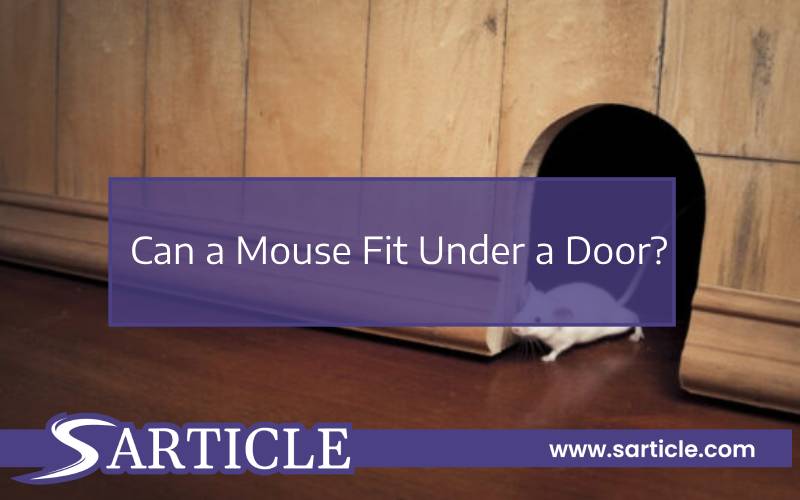Mice are small, agile creatures known for their ability to squeeze through tight spaces. One question that often comes to mind is whether a mouse can fit under a door. In this article, we will explore the topic in detail and provide comprehensive information on the physical capabilities of mice, their behaviors, and the factors that determine whether they can fit under a door or not.
Understanding the Anatomy and Behavior of Mice
Size and Flexibility
Mice are small rodents with slender bodies and flexible skeletons. Adult mice typically measure around 2.5 to 4 inches in length, excluding their tails. Their bodies are designed to navigate narrow crevices and tight spaces, allowing them to explore and find shelter in various environments.
Bone Structure
One of the key factors that enable mice to squeeze through small openings is their bone structure. Mice possess a remarkable ability called “craniocaudal compressibility.” This means that their skulls, ribs, and vertebrae can compress to a certain extent, allowing them to flatten their bodies and fit through narrow gaps.
Whiskers and Tactile Sensitivity
Mice rely heavily on their whiskers, also known as vibrissae, to navigate and explore their surroundings. Whiskers are highly sensitive to touch and provide mice with valuable information about their environment. By using their whiskers to detect obstacles and gauge the width of openings, mice can make calculated decisions on whether they can fit through a particular space, such as under a door.
Natural Behavior and Curiosity
Mice are curious creatures by nature, constantly seeking food, shelter, and nesting sites. They possess a strong drive to explore their surroundings, which often leads them to squeeze through small openings in search of resources. This innate behavior further highlights their ability to fit through narrow gaps, including under doors.
Factors Affecting a Mouse’s Ability to Fit Under a Door
Gap Size
The size of the gap between the bottom of a door and the floor is a crucial factor in determining whether a mouse can fit through. Mice can typically fit through openings as small as a quarter of an inch (6 mm) in height. If the gap is larger than this, it becomes easier for a mouse to fit through.
Door Material and Flexibility
The material and flexibility of the door also play a role. Mice are adept at navigating various surfaces, including wood, plastic, and metal. Doors made of softer materials or with some degree of flexibility may provide additional opportunities for mice to squeeze through.
Body Size and Condition
The size and physical condition of the mouse itself also affect its ability to fit under a door. Young mice or smaller adult mice will generally have an easier time fitting through narrow gaps compared to larger mice. Additionally, mice that are malnourished or sick may be more emaciated and therefore more capable of fitting through smaller openings.
Motivation and Determination
Mice are resourceful creatures, and their motivation to access food, water, or shelter can drive them to attempt to fit through openings that may seem impossible. Their determination, coupled with their physical capabilities, can sometimes lead to surprising feats of squeezing through narrow gaps, including under doors.
Conclusion
In conclusion, mice possess incredible physical abilities and behaviors that allow them to fit through small openings, including under doors. Their size, flexibility, bone structure, and curiosity enable them to navigate narrow gaps in search of resources and shelter. While mice can fit through relatively small spaces, certain factors such as gap size, door material, and their own size and condition influence their ability to squeeze through. Taking preventative measures to seal gaps and maintain proper door integrity can help minimize the risk of mice entering homes. If a mouse infestation is suspected, seeking professional assistance is advisable to address the issue promptly and effectively.
Frequently Asked Questions (FAQs)
Can a mouse fit through any gap?
While mice are highly adaptable and can fit through remarkably small openings, there are limits to their abilities. They cannot fit through gaps that are smaller than their skull size or gaps that require significant force to compress their bodies. However, they can fit through gaps as small as a quarter of an inch (6 mm) in height.
Do mice prefer to enter homes through doors?
Mice are opportunistic and will seek any available entry point into a structure, including doors, windows, cracks, or holes. However, doors are often more challenging for them to access due to human activity and the presence of thresholds. Mice may prefer to exploit other openings that provide easier access.
How can I prevent mice from entering through doors?
To prevent mice from entering through doors, it is essential to ensure that the doors are properly sealed. Install weatherstripping or door sweeps to close any gaps between the door and the floor. Regularly inspect and repair any damaged or worn-out seals to maintain a tight barrier against mouse intrusion.
Are there any health risks associated with mice entering homes?
Yes, mice can pose health risks when they enter homes. They can contaminate food, transmit diseases, and cause property damage through gnawing. It is crucial to address any mouse infestations promptly and take preventive measures to keep mice out of living spaces.
Can mice fit through closed doors?
Generally, mice cannot fit through properly closed doors. However, they may exploit gaps or cracks around the door frame, hinges, or other weak points. Regular inspection and maintenance of door frames and surrounding areas can help prevent mice from finding entry points.
What should I do if I suspect mice have entered my home?
If you suspect mice have entered your home, it is important to take swift action. Begin by sealing any potential entry points and removing potential food and water sources. Consider contacting a pest control professional who can assess the situation, implement effective control measures, and provide guidance on preventing future infestations.


